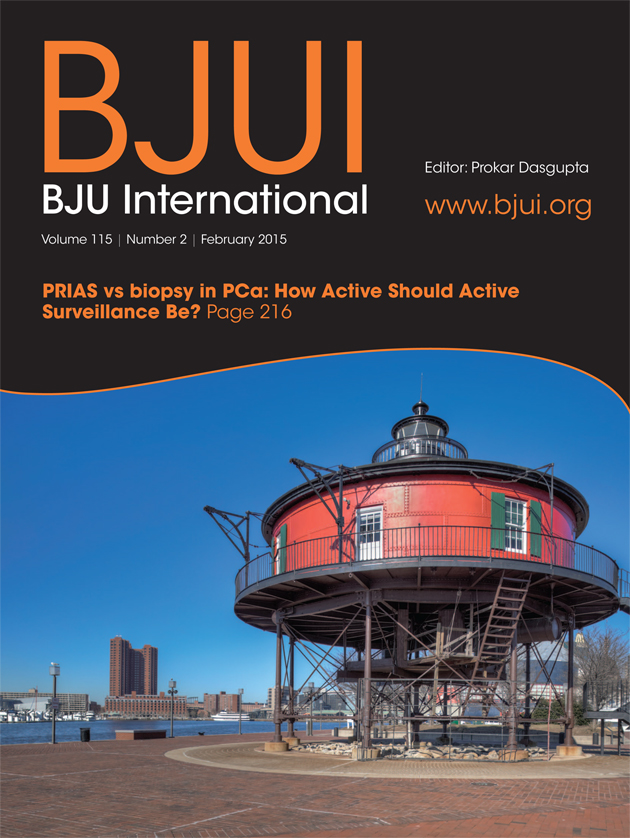With the expansion in laser technology for treating symptomatic BPH, there are now two main techniques available to the budding urologist. Yet the management of chronic urinary retention (CUR) remains a significant challenge. In this issue of BJUI Jaeger et al. [1]present a retrospective study comparing holmium laser enucleation of the prostate (HoLEP) and photoselective vaporization of the prostate (PVP; using XPS 180 watt and HPS 120 watt systems) in the treatment of CUR.
Both HoLEP and PVP are now well-established treatment methods. Although PVP has seen a greater level of acceptance because of its shorter learning period, its use remains limited by prostate size and concerns about long-term durability. In contrast the favourable and enduring outcomes reported for HoLEP have meant that it is gaining recognition as the new ‘gold standard’ surgical treatment for BPH. Whilst PVP ablates the tissue laterally from the prostatic urethra, HoLEP involves an anatomical enucleation of all the prostatic adenoma before morcellation.
Over the past decade, there has been a shift towards medical management of BPH. Despite the resultant increase in numbers of men developing CUR, best practice for this challenging and clinically important group remains highly debated. The term CUR is used to describe a constellation of presentations, and current imprecise, even arbitrary, definitions make the interpretation of existing studies difficult. Historically, CUR has been almost universally excluded from trials because of the anticipation of poor outcomes and high complication rates, while the presence of detrusor hypotonia, particularly with low-pressure retention, has led to concerns of treatment failure following surgery. This dilemma for urologists has been aggravated by conflicting evidence in the published literature [2].
Jaeger et al. [1] assessed all patients with CUR who were treated in their institution either with HoLEP (72 patients) or PVP (31 patients). CUR was defined as a persistent post-void residual urine volume (PVR) >300 mL or urinary retention refractory to multiple voiding trials. While preoperative urodynamic studies were not routinely performed, those patients found to have low bladder contractility or acontractility were not excluded.
Both HoLEP and PVP produced similarly effective outcomes in terms of symptom score improvement, PVR reduction and Qmax increase in voiding patients. Complication rates were also similar in the two groups (15 and 26% for HoLEP and PVP, respectively, P = 0.27), but, importantly, HoLEP was shown to offer substantially better rates of spontaneous voiding than PVP, 99 vs 74% of patients, in spite of a lower median bladder contractility index in the HoLEP group (73 vs 90, P = 0.012).
Both PVP and HoLEP have previously been studied in isolation in treating patients with CUR. Whilst Woo et al. [3] demonstrated significant reductions in PVR after PVP (GreenLight HPS 120-W), the presence of detrusor under-activity was not established. Outcomes after PVP in patients with urodynamically proven detrusor hypotonia have been shown to be significantly worse than in patients with normal detrusor funtion [4].
The findings from the present study further support the use of HoLEP specifically in CUR. Jaeger et al. are the first to compare the two technologies head on, albeit in a non-randomised study, in the treatment of CUR. Whilst both treatments showed reasonable efficacy despite low or absent bladder contractility in a number of patients, a significant advantage was seen with HoLEP, with the total removal of any obstructing tissue. These results were unaffected by the presence of preoperative impaired bladder on urodynamic studies. This study suggests that HoLEP is superior to PVP in the treatment of CUR, probably because of the larger prostatic channel that enucleation produces. Measurement of postoperative PSA readings would have been a useful addition to illustrate this. Nevertheless, the findings add to the growing body of evidence to support the use of HoLEP in treating CUR, irrespective of preoperative bladder function.
Nicholas Raison and Ben Challacombe
Urology Department, Guy’s and St Thomas’ NHS Trust, Guy’s Hospital, Great Maze Pond, London, UK
References
1 Jaeger CD, Mitchell CR, Mynderse LA, Krambeck AE. Holmium laser enucleation and photoselective vaporization of the prostate for patients with benign prostatic hyperplasia and chronic urinary retention. BJU Int 2015; 115: 295–9
2 Ghalayini IF, Al-Ghazo MA, Pickard RS. A prospective randomized trial comparing transurethral prostatic resection and clean intermittent self-catheterization in men with chronic urinary retention. BJU Int 2005; 96: 93–7
3 Woo H, Reich O, Bachmann A et al. Outcome of GreenLight HPS 120-W laser therapy in specific patient populations: those in retention, on anticoagulants, and with large prostates (≥ 80 ml). Eur Urol Suppl 2008; 7: 378–83
4 Monoski MA, Gonzalez RR, Sandhu JS, Reddy B, Te AE. Urodynamic predictors of outcomes with photoselective laser vaporization prostatectomy in patients with benign prostatic hyperplasia and preoperative retention. Urology 2006; 68: 312–7
5 Elzayat EA, Habib EI, Elhilali MM. Holmium laser enucleation of prostate for patients in urinary retention. Urology 2005; 66: 789–93
6 Mitchell CR, Mynderse LA, Lightner DJ, Husmann DA, Krambeck AE. Efficacy of holmium laser enucleation of the prostate in patients with non-neurogenic impaired bladder contractility: results of a prospective trial. Urology 2014; 83: 428–32



